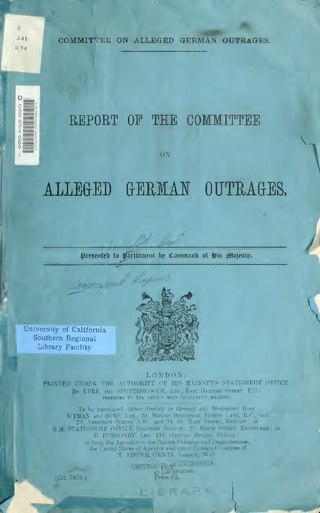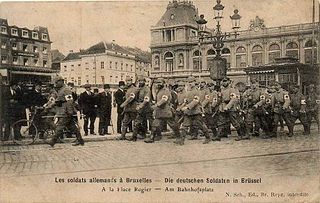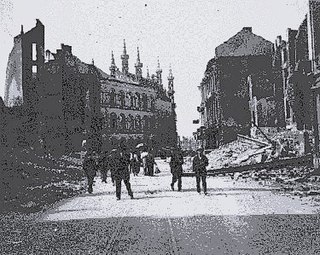Related Research Articles

The Waffen-SS was the combat branch of the Nazi Party's paramilitary Schutzstaffel (SS) organisation. Its formations included men from Nazi Germany, along with volunteers and conscripts from both occupied and unoccupied lands. It was disbanded in May 1945.

Georg Carl Wilhelm Friedrich von Küchler was a German Generalfeldmarschall of the Wehrmacht during the Second World War, who was subsequently convicted of war crimes. He commanded the 18th Army and Army Group North during the Soviet-German war of 1941–1945.

Franz Halder was a German general and the chief of staff of the Army High Command (OKH) in Nazi Germany from 1938 until September 1942. During World War II, he directed the planning and implementation of Operation Barbarossa, the 1941 invasion of the Soviet Union. Halder became instrumental in the radicalisation of warfare on the Eastern Front. He had his staff draft both the Commissar Order and the Barbarossa Decree that allowed German soldiers to execute Soviet citizens for any reason without fear of later prosecution, leading to numerous war crimes and atrocities during the campaign. After the war, he had a decisive role in the development of the myth of the clean Wehrmacht.

Johannes Albrecht Blaskowitz was a German Generaloberst during World War II. He was a recipient of the Knight's Cross of the Iron Cross with Oak Leaves and Swords. After joining the Imperial German Army in 1901, Blaskowitz served throughout World War I, where he earned an Iron Cross for bravery.

The Battle of Liège [also French: Bataille de Liège] was the opening engagement of the German invasion of Belgium and the first battle of the First World War. The city of Liège was protected by a ring of modern fortresses to form the Fortified position of Liège, one of several fortified cities to delay an invasion to allow troops from the powers which had guaranteed Belgian neutrality to assist the Belgian Army in the expulsion of the invaders.

In the German language, Festung Warschau is the term used to refer to a fortified and well-defended Warsaw. In the 20th century, the term was in use on three occasions during World War I and World War II. It was used when the Germans threw back the Russian advance in 1914, where Warsaw came within distance of the fighting in October. The term resurfaced during the September 1939 German invasion of Poland. Later in the second war, the term resurfaced between September 1944 and January 1945, when the retreating Germans tried to establish a defense in the city against the advancing Soviet Union.

The 1st SS Panzer Division Leibstandarte SS Adolf Hitler or SS Division Leibstandarte, abbreviated as LSSAH, began as Adolf Hitler's personal bodyguard unit, responsible for guarding the Führer's person, offices, and residences. Initially the size of a regiment, the LSSAH eventually grew into an elite division-sized unit during World War II.

The SS Division Hitlerjugend or 12th SS Panzer Division "Hitlerjugend" was a German armoured division of the Waffen-SS during World War II. The majority of its junior enlisted men were drawn from members of the Hitler Youth, while the senior NCOs and officers were from other Waffen-SS divisions.

The Dirlewanger Brigade, also known as the SS-Sturmbrigade Dirlewanger (1944), or the 36th Waffen Grenadier Division of the SS, or The Black Hunters, was a unit of the Waffen-SS during World War II. The unit, named after its commander Oskar Dirlewanger, consisted of convicted criminals who were not expected to survive their service with the unit. Originally formed from convicted poachers in 1940 and first deployed for counter-insurgency duties against the Polish resistance movement, the brigade saw service in anti-partisan actions in German-occupied Eastern Europe.

The Rape of Belgium was a series of systematic war crimes, especially mass murder and deportation, by German troops against Belgian civilians during the invasion and occupation of Belgium during World War I.

During World War II, the German Wehrmacht committed systematic war crimes, including massacres, mass rape, looting, the exploitation of forced labor, the murder of three million Soviet prisoners of war, and participated in the extermination of Jews. While the Nazi Party's own SS forces was the organization most responsible for the genocidal killing of the Holocaust, the regular armed forces of the Wehrmacht committed many war crimes of their own, particularly on the Eastern Front.

The Vinkt massacre was a war crime committed by German soldiers in the villages of Vinkt and Meighem in East Flanders on 26–28 May 1940 during the Battle of the Lys. Between 86 and 140 civilians were deliberately killed by Wehrmacht troops from the 377th Infantry Regiment of the 225th Infantry Division, supposedly in retaliation for the Belgian Army's resistance in the village.

The governments of the German Empire and Nazi Germany ordered, organized, and condoned a substantial number of war crimes, first in the Herero and Namaqua genocide and then in the First and Second World Wars. The most notable of these is the Holocaust, in which millions of European Jewish, Polish, and Romani people were systematically abused, deported, and murdered. Millions of civilians and prisoners of war also died as a result of German abuses, mistreatment, and deliberate starvation policies in those two conflicts. Much of the evidence was deliberately destroyed by the perpetrators, such as in Sonderaktion 1005, in an attempt to conceal their crimes.

The Committee on Alleged German Outrages, often called the Bryce Report after its chair, Viscount James Bryce (1838–1922), is best known for producing the "Report of the Committee on Alleged German Outrages," published on 12 May 1915. The report is seen as a major propaganda form that Britain used in order to influence international public opinion regarding the behaviour of Germany, which had invaded Belgium the year before. It was the first significant publication from the War Propaganda Bureau at Wellington House.

This is the order of battle for the Belgian Army at the start of the German invasion of Belgium in August 1914.

Karl Hubert Lanz was a German general during the Second World War, in which he led units in the Eastern Front and in the Balkans. After the war, he was tried for war crimes and convicted in the Southeast Case, specifically for several atrocities committed by units under his command in the Balkans. Released in 1951, he joined the liberal Free Democratic Party and served as its adviser on military and security issues.

The German invasion of Belgium was a military campaign which began on 4 August 1914. On 24 July, the Belgian government had announced that if war came it would uphold its neutrality. The Belgian government mobilised its armed forces on 31 July and a state of heightened alert was proclaimed in Germany. On 2 August, the German government sent an ultimatum to Belgium, demanding passage through the country and German forces invaded Luxembourg. Two days later, the Belgian government refused the German demands and the British government guaranteed military support to Belgium. The German government declared war on Belgium on 4 August; German troops crossed the border and began the Battle of Liège.

The history of Belgium in World War I traces Belgium's role between the German invasion in 1914, through the continued military resistance and occupation of the territory by German forces to the armistice in 1918, as well as the role it played in the international war effort through its African colony and small force on the Eastern Front.

The German occupation of Belgium of World War I was a military occupation of Belgium by the forces of the German Empire between 1914 and 1918. Beginning in August 1914 with the invasion of neutral Belgium, the country was almost completely overrun by German troops before the winter of the same year as the Allied forces withdrew westwards. The Belgian government went into exile, while King Albert I and the Belgian Army continued to fight on a section of the Western Front. Under the German military, Belgium was divided into three separate administrative zones. The majority of the country fell within the General Government, a formal occupation administration ruled by a German general, while the others, closer to the front line, came under more repressive direct military rule.

The Burning of Leuven was the German assault on the Belgian town of Leuven, part of the events collectively known as the Rape of Belgium, taking place during the First World War. Over the course of several days of pillaging and brutality 248 people were killed and 1,500 were deported to Germany where they were held at the Munster camp until January 1915. The Library of the Catholic University of Leuven was completely destroyed after it was set on fire by the occupying German soldiers and 1,120 of the 8,928 homes in Leuven were similarly destroyed.
References
- 1 2 3 4 "Schrecklichkeit". Haverford University. Archived from the original on 20 August 2008. Retrieved 6 June 2022.
- ↑ "German policy was based on Schrecklichkeit ('dreadfulness' or 'frightfulness'). During their advance through Belgium in 1914 the German Army massacred hundreds of civilians and burned down towns and villages in reprisal for acts of resistance, real or imagined, and to deter the population." Stewart, Ian. War, Culture, and the Media. Fairleigh Dickinson Univ Press, 1996. Page 57.
- ↑ March, Francis Andrew; Beamis, Richard J. History of the World War Plain Label Books, 1918. page 63
- ↑ Tuchman, Barbara. The Guns of August , Random House, 2009, pp. 130-132.
- ↑ Rachamimov, Alon. "The Etiology of War Crimes and the Complexities of Remembrance". Review of Horne, John N.; Kramer, Alan. German Atrocities, 1914: A History of Denial. New Haven: Yale University Press, 2001 ISBN 978-0-300-08975-2.
- ↑ Thomas Weber (2010), Hitler's First War: Adolf Hitler, the Men of the List Regiment, and the First World War, Oxford University Press. Pages 35-41.
- ↑ Zudeick, Peter (19 November 2012). "Order makes Germans' world go round". dw.com. Retrieved 16 September 2016.
- ↑ Thomas Weber (2010), Hitler's First War: Adolf Hitler, the Men of the List Regiment, and the First World War, Oxford University Press. Page 37.
- ↑ Thomas Weber (2010), Hitler's First War: Adolf Hitler, the Men of the List Regiment, and the First World War, Oxford University Press. Page 36.
- ↑ "Schrecklichkeit, die". Duden (in German). Retrieved 24 September 2023.